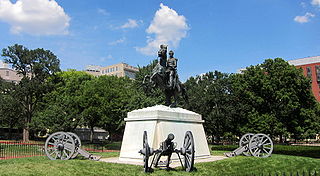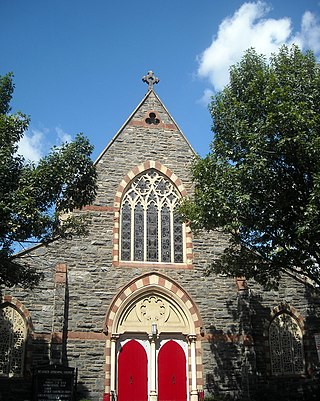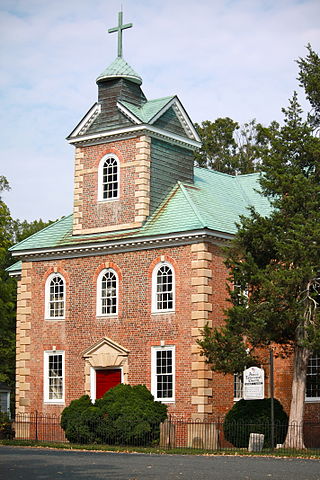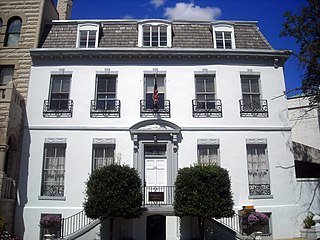
The Episcopal Diocese of Washington is a diocese of the Episcopal Church covering Washington, D.C. and nearby counties of Maryland in the United States. With a membership of over 38,000, the diocese is led by the Bishop of Washington, Mariann Budde. It is home to Washington National Cathedral, which is the seat of both the diocesan bishop and the Presiding Bishop of the Episcopal Church.

St. John's Episcopal Church, Lafayette Square is an historic Episcopal church located at Sixteenth Street and H Street NW, in Washington, D.C., along Black Lives Matter Plaza. The Greek Revival building, designed by Benjamin Latrobe, is adjacent to Lafayette Square, one block from the White House. It is often called the "Church of the Presidents".

The Church of the Ascension is an Episcopal church in the Diocese of New York, located at 36–38 Fifth Avenue and West 10th Street in the Greenwich Village neighborhood of Manhattan New York City. It was built in 1840–41, the first church to be built on Fifth Avenue and was designed by Richard Upjohn in the Gothic Revival style. The interior was remodeled by Stanford White in 1885–88.

St. Paul's Chapel is a chapel building of Trinity Church, an episcopal parish, located at 209 Broadway, between Fulton Street and Vesey Street, in Lower Manhattan, New York City. Built in 1766, it is the oldest surviving church building in Manhattan, and one of the nation's finest examples of Late Georgian church architecture.

The Chester A. Arthur Home was the residence of the 21st President of the United States, Chester A. Arthur (1829–1886), both before and after his four years in Washington, D.C., while serving as vice president and then as president. It is located at 123 Lexington Avenue, between 28th and 29th Streets in Rose Hill, Manhattan, New York City. Arthur spent most of his adult life living in the residence. While Vice President, Arthur retreated to the house after the July 2, 1881 shooting of President James Garfield. Arthur was in residence here when Garfield died on September 19, and took the presidential oath of office in the building. A commemorative bronze plaque was placed inside the building in 1964 by the Native New Yorkers Historical Society and New York Life Insurance, and the house was designated a National Historic Landmark on January 12, 1965.

The Belmont–Paul Women's Equality National Monument is a historic house and museum of the U.S. women's suffrage and equal rights movements located in the Capitol Hill neighborhood of Washington, D.C. The monument is named after suffragists and National Woman's Party leaders Alva Belmont and Alice Paul.

The Lafayette Square Historic District is a National Historic Landmark District in Washington, D.C., encompassing a portion of the original L'Enfant Plan for the city's core. It includes the 7-acre (2.8 ha) Lafayette Square portion of President's Park, all of the buildings facing it except the White House, and the buildings flanking the White House to the east and west. The district was designated a National Historic Landmark in 1970.

The Cleveland Abbe House, also known as the Timothy Caldwell House and Monroe-Adams-Abbe House, is a historic house at 2017 "I" Street NW in Washington, D.C. Built in 1805, it is a good example of Federal period architecture, and has had a series of distinguished residents. Most notable are James Monroe, who occupied it as United States Secretary of War and as President of the United States while the White House was restored after the War of 1812, and historian Henry Adams. However, it was designated a National Historic Landmark in 1975 for its association with meteorologist Cleveland Abbe (1838–1916), the founder of the National Weather Service, who lived here from 1877 until his death. It is now home to the Arts Club of Washington.

St. Luke's Episcopal Church is a historic Episcopal church located at 1514 15th Street, N.W., in Washington, D.C. Completed in 1879, it is home to the oldest African-American Episcopal congregation in the city. It was designated a U.S. National Historic Landmark in 1976 for its association with Rev. Alexander Crummell (1819–1898), a leading figure advocating black self-sufficiency and civil rights in the mid-19th century.

Aquia Church is a historic church and congregation at 2938 Richmond Highway in Stafford, Virginia, USA. It is an Episcopal congregation founded in 1711, that meets in an architecturally exceptional Georgian brick building that was built in the 1750s. The building was designated a National Historic Landmark in 1991 for its architectural importance. It maintains an active congregation with a variety of programs and outreach to the community.

The Charleston, South Carolina studio of sculptor Clark Mills, was his first—he worked there from 1837 to 1848, when he moved to Washington, DC. The Charleston studio was designated as a National Historic Landmark in 1965. Before it became Mills' studio, the building, located at 51 Broad Street, Charleston originally served as a tenement house, and now houses professional offices.
St. Michael's AnglicanChurch is a historic church and the oldest surviving religious structure in Charleston, South Carolina. It is located at Broad and Meeting streets on one of the Four Corners of Law, and represents ecclesiastical law. It was built in the 1750s by order of the South Carolina Assembly. It is listed on the National Register of Historic Places and is a National Historic Landmark.

The American Peace Society House, also known as the Glover House, is a historic house at 734 Jackson Place NW, facing Lafayette Square in the heart of Washington, D.C. Built in 1878 for banker and philanthropist Charles Carroll Glover, it is most notable as the national headquarters of the American Peace Society from 1911 to 1948. The Peace Society was one of the first overtly pacifist organizations in the nation, with a history dating to 1815. The house was declared a National Historic Landmark in 1974.

The General Federation of Women's Clubs Headquarters, also known as the Miles Mansion, is a social clubhouse headquarters in Washington, D.C. Built as a private residence in 1875, it has served as the headquarters of the General Federation of Women's Clubs (GFWC) since 1922. It was declared a National Historic Landmark in 1991 for its association with the federation, which serves as an umbrella organization for women's clubs, a social movement dating to the mid-19th century. Tours of the headquarters, available by appointment, provide information about the activities of the GFWC and several historic rooms, including the 1734 entryway, the Julia Ward Howe Drawing Room, the dining room, music room and the GFWC International President's office. The headquarters also features changing exhibits of art, photographs and artifacts from its collections.

The Peter Parker House, also known as the former headquarters of the Carnegie Endowment for International Peace, is a historic row house at 700 Jackson Place NW in Washington D.C. Built in 1860, it is historically significant for its association with the Carnegie Endowment, whose headquarters it was from its founding in 1910 until 1948. The building was declared a National Historic Landmark in 1974. It has since been incorporated into the Blair House complex serving high-profile official visitors to the capital.

The Hiram W. Johnson House, also known as Mountjoy Bayly House, Chaplains Memorial Building or Parkington, is an historic house at 122 Maryland Avenue, Northeast, Washington, D.C., in the Capitol Hill neighborhood. Built about 1822, it is most notable as the home of Hiram Johnson (1866–1945), a prominent force in the Progressive Party of the early 20th century and its vice presidential candidate under Theodore Roosevelt in the 1912 election. It was declared a National Historic Landmark in 1976, and contributing property to the Capitol Hill Historic District.

The John E. Booth House is a historic house located in Provo, Utah. John E. Booth was a significant Provoan, and was extensively involved in Provo's community and religious affairs. Located at 59 West and 500 North and less than one acre in size, the John E. Booth House was built in 1900, and happens to be the only 2+1⁄2-story Victorian Mansion in Provo, Utah. This house is significant not only as a Victorian mansion, but because its "Bricks were individually painted to create a variegrated design effect". The house was added to the National Register of Historic Places in 1982. The house was designated to the Provo City Historic Landmark Register on May 26, 1995.

The Greenville Downtown Historic District is a commercial historic district located in Greenville, Michigan along Lafayette between Montcalm and Benton, along with the adjacent blocks of Montcalm, Grove, Cass, and Washington on either side. It was listed on the National Register of Historic Places in 2008.

Goshen Historic District is a national historic district located at Goshen, Elkhart County, Indiana. The district encompasses 751 contributing buildings and 1 contributing site in the central business district and surrounding residential sections of Goshen. The town was developed between about 1840 and 1930, and includes notable examples of Italianate and Queen Anne style architecture. Located with in the district are the separately listed Elkhart County Courthouse and Goshen Carnegie Public Library. Other notable buildings include the Kindy Block (1881), Central Block (1882), Spohn Building (1909), Harper Block (1888), Noble Building, Jefferson Theater (1907), General Baptist Church (1859), First Methodist Church (1874), and St. James Episcopal Church (1862).

Harris Hall is an auditorium located at 617 East Huron Street in Ann Arbor, Michigan. It was listed on the National Register of Historic Places in 1982.





















